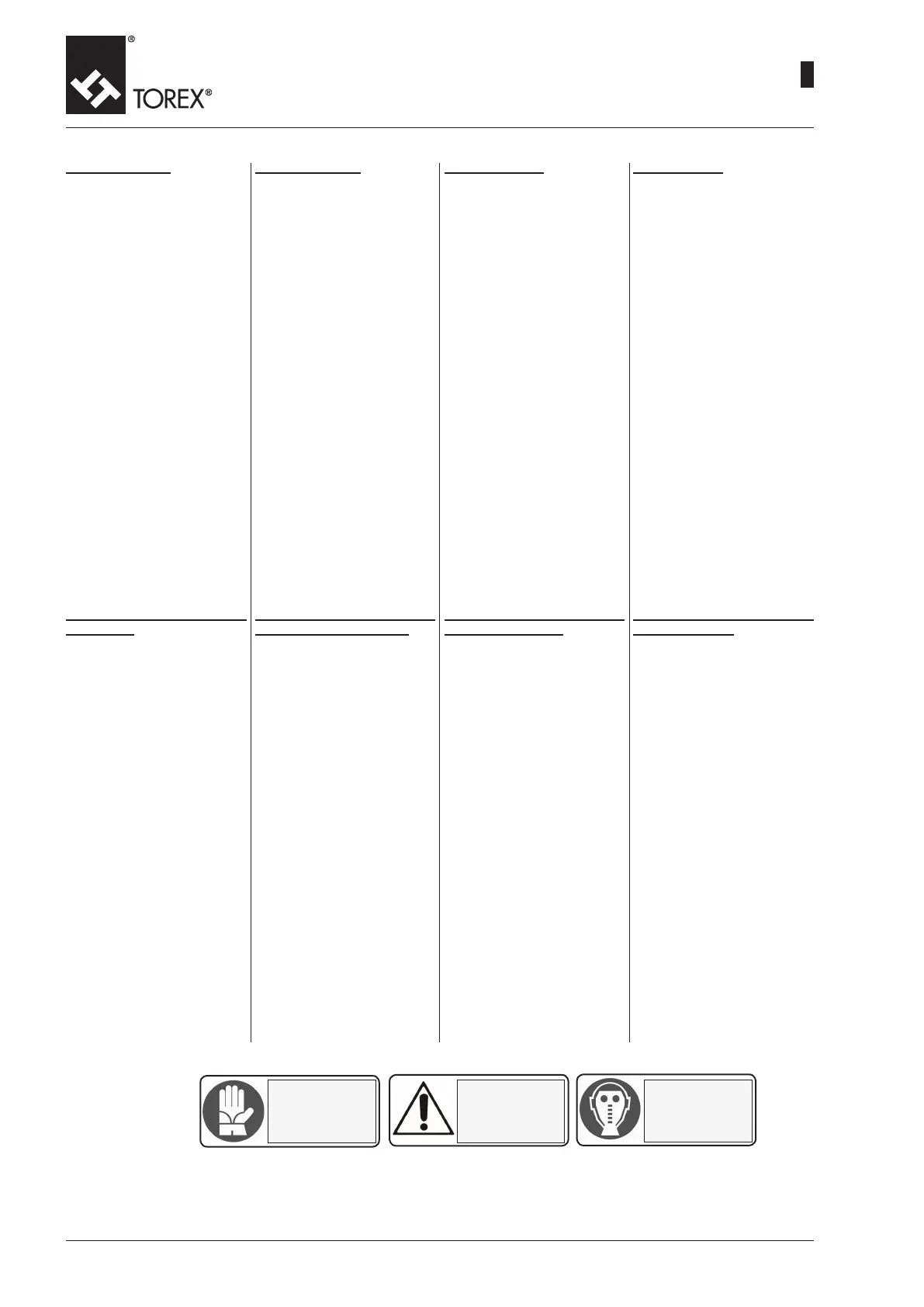2
TOR.089.--.M.4L-PL
09.16
-
-
-
-
RV
RVR
RESIDUALRISKS
RESTRISIKEN
RISQUESRESIDUELS
POZOSTAŁERYZYKA
42
Lärm,Vibrationen
Der Benutzer ist, wie es in diesem
Handbuch angegeben ist, dazu
verpflichtet, bei laufender und
mit Material gefüllter Zellenrad-
schleuse geeignete Messungen
auszuführen.
Der Benutzer und der Arbeitgeber
müssen die gesetzlichen Bestim-
mungen zum Schutz gegen die
tägliche persönliche Lärmexposi-
tion der Arbeitsnehmer durch die
etwaige Vorschrift zur Benutzung
der persönlichen Schutzausrü-
stungen (Gehörschutz etc.) je
nach dem Gesamtschalldruck, der
in jedem einzelnen Arbeitsbereich
vorhanden ist und dem täglichen
persönlichen Expositionsniveau
der Arbeitnehmer beachten.
Außerdem ist es erforderlich, die
Zellenradschleuse abzuschal-ten,
falls man Lärm oder Schwin-
gungen feststellt, die man als
nicht normal betrachtet (Bez.
Handbuch RV, Kap.2 Abs. „HIN-
WEISE”, Handbuch RVS/C Kap.
2 Abs. „BETRIEB”).
Emissionenvon gefährlichen
Materialien/Schadstoffen
Sowohl im Fall laufender oder au-
ßerordentlicher Wartungseingriffe
als auch der Reinigung oder des
Ausbaus der Zellenradschleuse
muss der Bediener sich mit per-
sönlichen Schutzausrüstungen
ausrüsten und insbe-sondere
Masken zum Schutz der Atem-
wege der Klasse benutzen, die
sich für den gelterten Staubtyp
eignet, aber auch Handschuhe
oder Schutzkleidung.
Für weitere Einzelheiten wird auf
die entsprechenden Abschnitte
in der Betriebsanleitung verwie-
sen (Handbuch RV, Kap 2, Abs.
„HINWEISE” und „WARTUNG”,
Handbuch RVS/C, Kap. 2 Abs.
„BETRIEB” und „WARTUNG”).
Es ist Aufgabe des Installateurs,
für die entsprechende Beschilde-
rung zu sorgen, die den Bedie-
nern die Verpichtung zur Benut-
zung der erforderlichen PSA und
das eventuelle Vorhandensein
von Schadstoffen meldet.
Bruit,Vibrations.
L’utilisateur a l’obligation, comme
indiqué dans le manuel, d’effec-
tuer des mesures du niveau
sonore quand la vanne rotative
est en marche avec le matériau.
L’utilisateur et l’employeur doivent
respecter les normes légales
en matière de protection contre
l’exposition personnelle quoti-
dienne des travailleurs au bruit
avec éventuellement la prescrip-
tion d’utiliser des équipements de
protection individuelle (casques,
etc.) en fonction du niveau total
de pression sonore présent dans
la zone de travail et du niveau
d’exposition quotidien personnel
des employés.
Il est en outre nécessaire d’arrê-
ter le distributeur en présence
de bruits ou de vibrations anor-
males, (réf. Manuel RV Chap.2
Sect.”AVERTISSEMENTS”,
Manuel RVS/C Chap.2
Sect.”FONCTIONNEMENT”).
Emissionsdematières/subs-
tancesdangereuses
En cas d’interventions ordinaires
ou extraordinaires d’entretien,
de nettoyage ou de dépose du
distributeur, l’opérateur doit se
doter d’équipements de protection
individuelle et notamment utiliser
des masques de protection des
voies respiratoires de classe
appropriée en fonction du type
de poussière ltrée, ainsi que de
gants ou de vêtements.
Pour plus de détails il est fait
renvoi à la section concernée
dans le manuel d’utilisation
(Man.RV, Chap.2 Sect. « AVER-
TISSEMENTS » et « ENTRE-
TIEN », Man.RVS/C, Chap.2
Sect. « FONCTIONNEMENT »
et « ENTRETIEN »).
L’installateur doit prévoir les
panneaux signalant à l’opérateur
l’obligation d’utiliser les E.P.I.
appropriés ainsi que la présence
de substances nocives.
Noise,Vibrations.
As indicated in the Manual, the
User must carry out measure-
ments with the rotary valve ope-
rating with material.
The user and employer must
respect the legal standards as
regards protection from daily
personal exposure of operators to
noise and, if necessary, prescribe
the use of personal protection de-
vices (ear muffs, etc.) depending
on the total noise level present in
the individual work areas and the
daily personal exposure level for
the workers.
The valve must be stopped if there
is abnormal noise or vibrations
(Ref. RV Manual Chap.2 Sect.
“WARNINGS”, RVS/C Manual
Chap.2 Sect. “OPERATION”).
Emissionsofhazardousmatter/
substances
While carrying out operations
involved in routine or extraordi-
nary maintenance, cleaning or
valve removal, the operator must
use suitable personal protection
equipment, especially, masks
to protect the respiratory tract
belonging to a class suitable for
the type of dust ltered, as well
as gloves or clothing.
For more details, refer to the
relevant sections of the Opera-
tion Manual (RV Manual, Chap.2
Sect. “WARNINGS” and “MAIN-
TENANCE”)
It is the installer’s responsibility
to provide the necessary warning
notices indicating that it is compul-
sory for the operators to use the
P.P.E. necessary and the potential
presence of harmful substances.
Hałas,wibracje
Zgodnie z zaleceniem instrukcji
użytkownik winien wykonać odpo-
wiednie pomiary poziomu hałasu
przy maszynie pracującej pod
obciążeniem.
Zarówno dysponent, jak i użyt-
kownik maszyny muszą prze-
strzegać odnośnych przepisów
dotyczących maksymalnej dzien-
nej ekspozycji pracownika na
hałas (norma PN-86/N-01321)
w połączeniu z przepisami dot.
stosowania środków ochrony in-
dywidualnej (art. 237 ust. 6 – 237
ust. 10 Kodeksu pracy). Przepisy
należy stosować z uwzględnie-
niem całkowitego ciśnienia aku-
stycznego, panującego w danym
miejscu pracy oraz dziennej, indy-
widualnej ekspozycji pracownika
na hałas. Ponadto należy pamię-
tać o niezwłocznym wyłącze-
niu śluzy celkowej w przypadku
stwierdzenia niestandardowych
hałasów lub drgań (patrz też in-
strukcja RV-RVR (część 2), sekcja
„WSKAZÓWKI”; instrukcja RVS/C
(część 2), sekcja „PRACA”).
Emisjeniebezpiecznychmate-
riałów/substancji
Zarówno w trakcie regularnych
i nadzwyczajnych prac kon-ser-
wacyjnych, jak i podczas czysz-
czenia personel winien używać
właściwych środków ochrony
indywidualnej, w szcze-gólności
masek odpowiedniej klasy, chro-
niących drogi odde-chowe przed
pyłem oraz rękawic ochronnych i
odzieży ochronnej.
Więcej informacji można zna-
-leźć w odpowiednim miejscu
in-strukcji obsługi i konserwacji
(patrz instrukcja RV-RVR (część
2), sekcje „WSKAZÓWKI” i „KON-
SERWACJA”; instrukcja RVS/C
(część 2), sekcje „PRACA” i
„KONSERWACJA”).
Instalator maszyny zobowiązany
jest umieścić specjalne tabliczki
ostrzegawcze, które nakazują
personelowi używanie środków
ochrony indywidualnej i wskazu-
-ją na możliwość występowania
szkodliwych pyłów.
